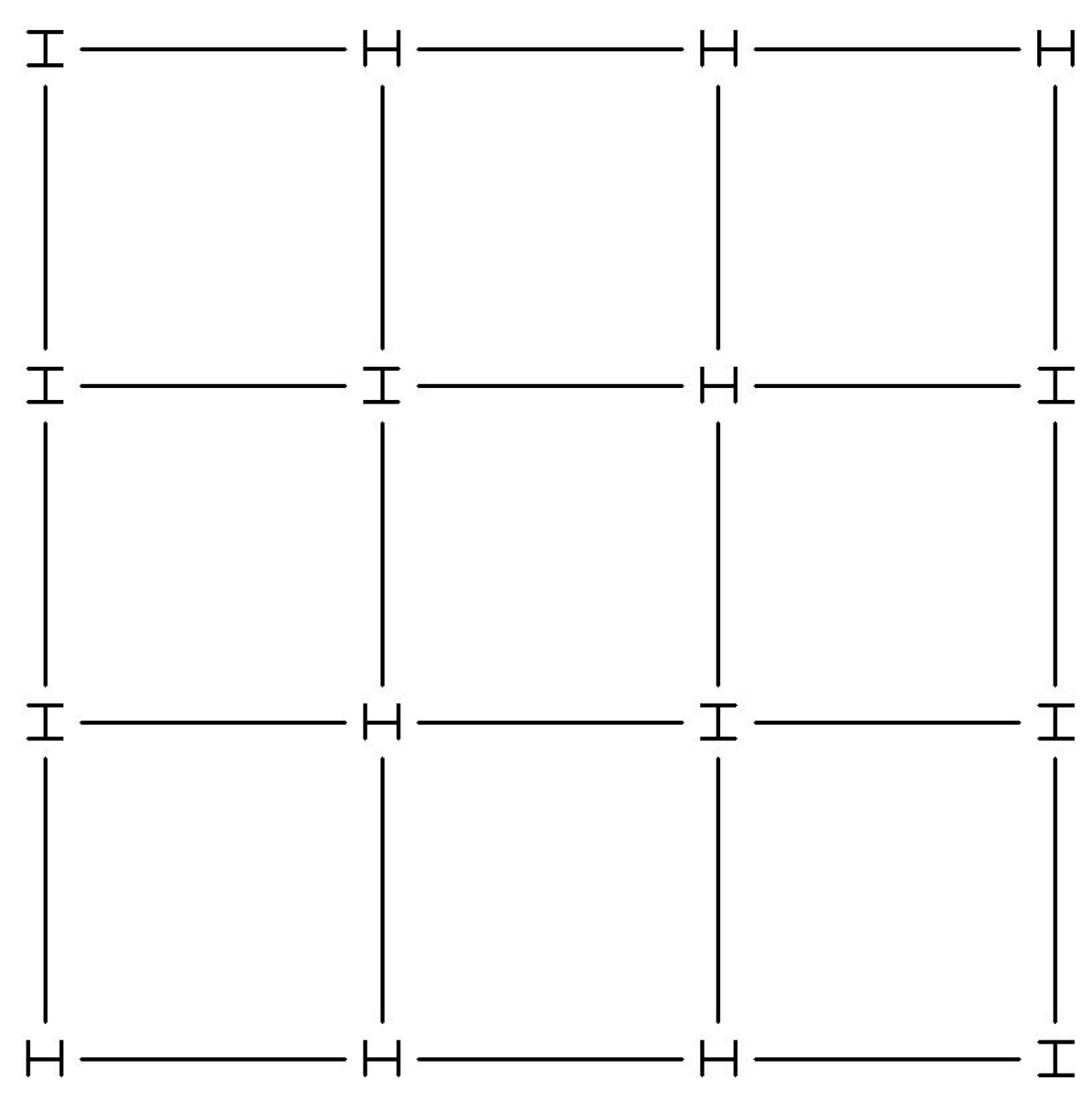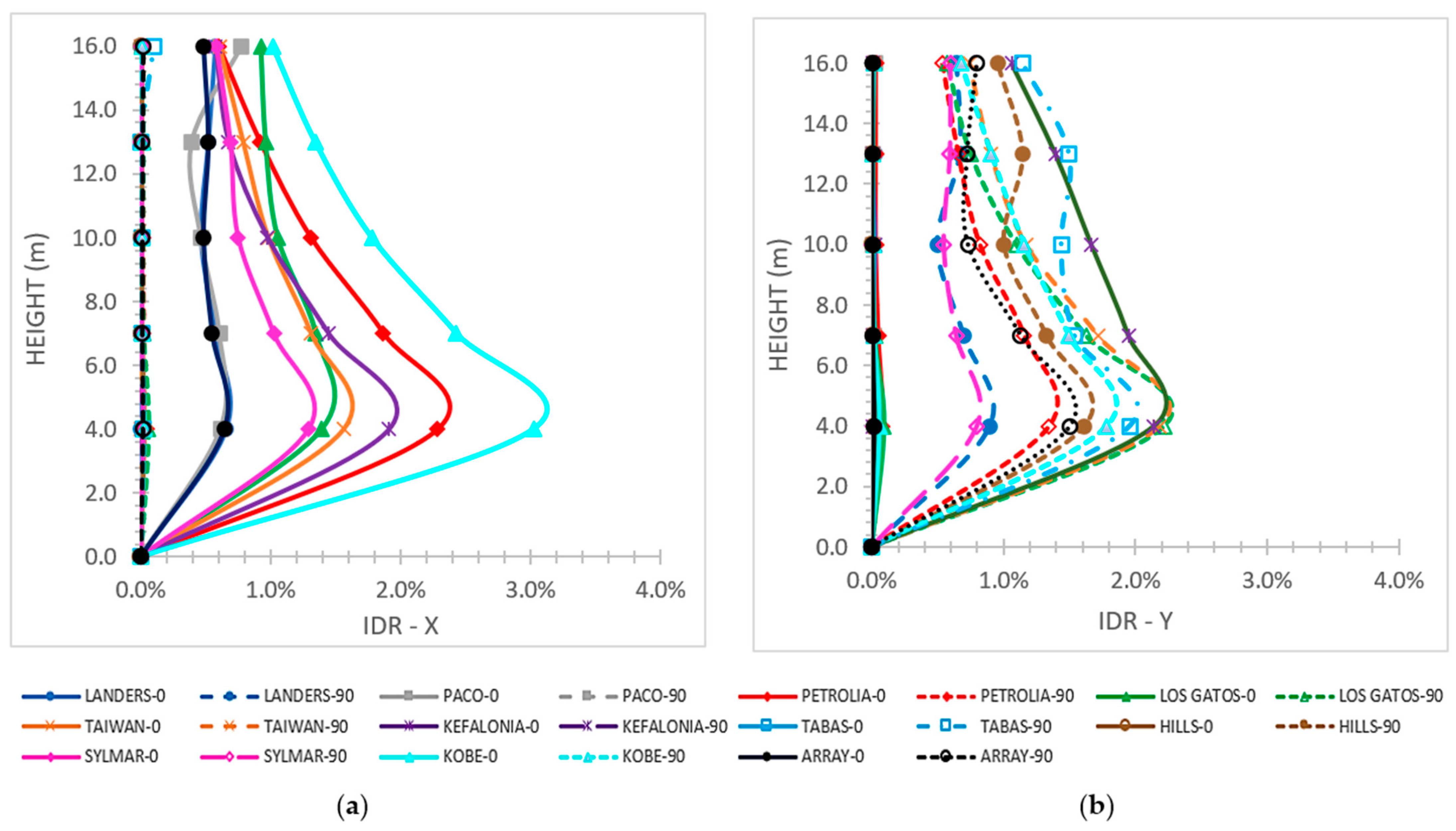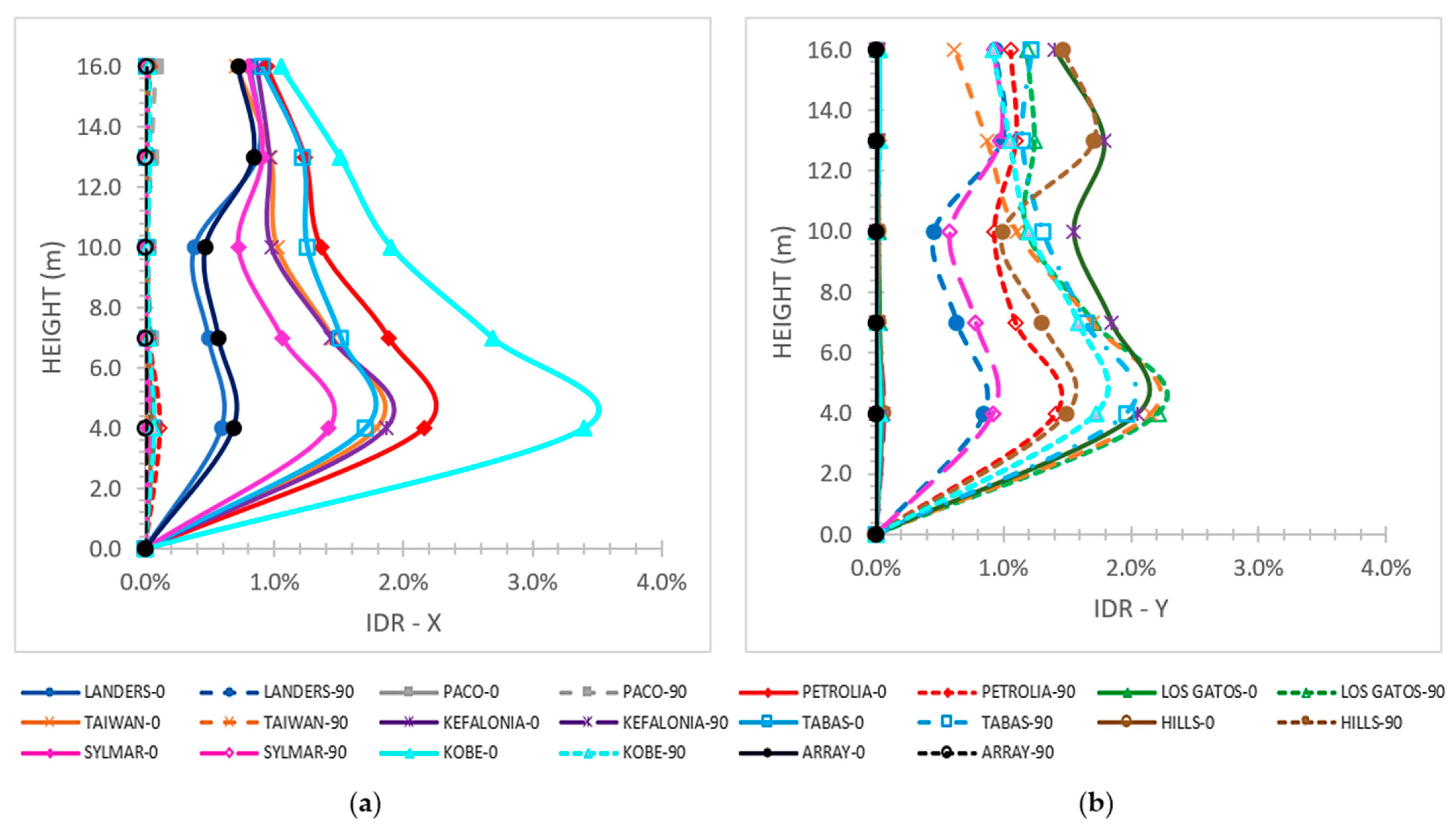The Non-Linear Behavior of Mixed Reinforced Concrete–Steel Frames under Strong Earthquakes †
Abstract
:1. Introduction
2. Mixed RC–Steel Building Cases and Analysis
3. Results and Discussion
4. Conclusions
- The fixed–pinned support of the steel stories upon the RC structure results in more failures of the mixed frames, contrasted with the fixed support.
- The IDR values are often smaller for the fixed–pinned support than for the fixed one.
- The IDR values are, in general, within the permissible range limits of the performance levels of the considered regulation, except for the cases of building failures.
- The steel elements tend to have almost elastic behavior, as shown by the low IDR response values of the steel stories. However, the RC structural elements show an intense nonlinear behavior, as observed from the great IDR response values of the RC stories.
Author Contributions
Funding
Institutional Review Board Statement
Informed Consent Statement
Data Availability Statement
Conflicts of Interest
References
- Eurocode 8 (EC8); Design of Structures for Earthquake Resistance—Part 1-1: General Rules, Seismic Actions and Rules for Buildings; European Committee for Standardization (CEN): Brussels, Belgium, 2004.
- Villaverde, R. Fundamental Concepts of Earthquake Engineering; CRC Press: Boca Raton, FL, USA, 2009. [Google Scholar]
- Maley, T.J.; Sullivann, T.J.; Pampanin, S. Issues with the seismic design of mixed MRF Systems. In Proceedings of the 15th World Conference on Earthquake Engineering, Lisboa, Portugal, 24–28 September 2012; Available online: http://www.iitk.ac.in/nicee/wcee/article/WCEE2012_4043.pdf (accessed on 3 May 2021).
- Sivandi-Pour, A.; Gerami, M.; Khodayarnezhad, D. Equivalent modal damping ratios for non-classically damped hybrid steel concrete buildings with transitional storey. Struct. Eng. Mech. 2014, 50, 383–401. [Google Scholar] [CrossRef]
- Eurocode 2 (EC2); Design of Concrete Structures—Part 1-1: General Rules and Rules for Buildings; European Committee for Standardization (CEN): Brussels, Belgium, 2004.
- Eurocode 3 (EC3); Design of Steel Structures—Part 1-1: General Rules and Rules for Buildings; European Committee for Standardization (CEN): Brussels, Belgium, 2009.
- Eurocode 1 (EC1); Actions on Structures—Part 1-1: General Actions, Densities, Self-Weight, Imposed Loads for Buildings; European Committee for Standardization (CEN): Brussels, Belgium, 2001.
- Askouni, P.K.; Papagiannopoulos, G.A. Seismic Behavior of a Class of Mixed Reinforced Concrete-Steel Buildings Subjected to Near-Fault Motions. Infrastructures 2021, 6, 172. [Google Scholar] [CrossRef]
- Carr, A.J. Ruaumoko 3D: Program for Inelastic Dynamic Analysis. Theory and User Guide to Associated Programs; Department of Civil Engineering, University of Canterbury: Christchurch, New Zealand, 2009. [Google Scholar]
- Center for Engineering Strong Motion Data. Available online: www.strongmotioncenter.org (accessed on 3 May 2021).
- ASCE 41-17; Seismic Evaluation and Retrofit of Existing Buildings. American Society of Civil Engineers: Reston, VA, USA, 2017.
- SEAOC. Recommended Lateral Force Requirements and Commentary, 7th ed.; Structural Engineers Association of California: Sacramento, CA, USA, 1999. [Google Scholar]






| Five-Story Building | Columns | Beams | ||||||
|---|---|---|---|---|---|---|---|---|
| Story Number | Height (m) | Materials | Section (cm/cm) | Longitudinal Reinforcement | Vertical Reinforcement | Section (cm/cm) | Longitudinal Reinforcement | Vertical Reinforcement |
| 1 | 4 | RC | 70/70 | 8Φ22 + 16Φ20 | Φ8/10 | 25/70 | 8Φ20 + 8Φ16 | Φ8/10 |
| 2 | 3 | RC | 70/70 | 16Φ20 | Φ8/10 | 25/70 | 8Φ20 + 8Φ10 | Φ8/10 |
| 3 | 3 | RC | 70/70 | 8Φ20 + 8Φ10 | Φ8/10 | 25/60 | 8Φ18 | Φ8/10 |
| 4 | 3 | steel | HEΒ 500 | IPE 360 | ||||
| 5 | 3 | steel | HEΒ 500 | IPE 300 | ||||
| Six-Story Building | Columns | Beams | ||||||
| Story Number | Height (m) | Materials | Section (cm/cm) | Longitudinal Reinforcement | Vertical Reinforcement | Section (cm/cm) | Longitudinal Reinforcement | Vertical Reinforcement |
| 1 | 4 | RC | 70/70 | 32Φ20 | Φ8/10 | 25/70 | 8Φ20 + 8Φ10 | Φ8/10 |
| 2 | 3 | RC | 70/70 | 16Φ20 | Φ8/10 | 25/70 | 8Φ18 | Φ8/10 |
| 3 | 3 | RC | 70/70 | 16Φ20 | Φ8/10 | 25/70 | 8Φ18 | Φ8/10 |
| 4 | 3 | RC | 70/70 | 16Φ20 | Φ8/10 | 25/70 | 8Φ18 | Φ8/10 |
| 5 | 3 | steel | HEA 500 | IPE 400 | ||||
| 6 | 3 | steel | HEA 500 | IPE 400 | ||||
| Earthquake, Location, Year | Name for Charts | Mw | PGA (g) |
|---|---|---|---|
| San Fernando, USA, 1971 | PACO | 6.6 | 1.17/1.08 |
| Tabas, Iran, 1978 | TABAS | 7.1 | 0.93/1.10 |
| Imperial Valley, USA, 1979 | ARRAY | 6.5 | 0.34/0.46 |
| Superstition Hills, USA, 1987 | HILLS | 6.5 | 0.45/0.38 |
| Loma Prieta, USA, 1989 | LOS GATOS | 7.0 | 0.56/0.61 |
| Cape Mendocino, USA, 1992 | PETROLIA | 6.9 | 0.66/0.59 |
| Landers, USA, 1992 | LANDERS | 7.3 | 0.81/0.73 |
| Northridge, USA, 1994 | SYLMAR | 6.7 | 0.37/0.58 |
| Kobe, Japan, 1995 | KOBE | 6.9 | 0.61/0.62 |
| Chi-Chi, Taiwan, 1999 | TAIWAN | 7.6 | 0.50/0.36 |
| Kefalonia, Greece, 2014 | KEFALONIA | 6.1 | 0.67/0.60 |
Disclaimer/Publisher’s Note: The statements, opinions and data contained in all publications are solely those of the individual author(s) and contributor(s) and not of MDPI and/or the editor(s). MDPI and/or the editor(s) disclaim responsibility for any injury to people or property resulting from any ideas, methods, instructions or products referred to in the content. |
© 2023 by the authors. Licensee MDPI, Basel, Switzerland. This article is an open access article distributed under the terms and conditions of the Creative Commons Attribution (CC BY) license (https://creativecommons.org/licenses/by/4.0/).
Share and Cite
Askouni, P.K.; Papagiannopoulos, G.A. The Non-Linear Behavior of Mixed Reinforced Concrete–Steel Frames under Strong Earthquakes. Eng. Proc. 2023, 53, 15. https://doi.org/10.3390/IOCBD2023-15197
Askouni PK, Papagiannopoulos GA. The Non-Linear Behavior of Mixed Reinforced Concrete–Steel Frames under Strong Earthquakes. Engineering Proceedings. 2023; 53(1):15. https://doi.org/10.3390/IOCBD2023-15197
Chicago/Turabian StyleAskouni, Paraskevi K., and George A. Papagiannopoulos. 2023. "The Non-Linear Behavior of Mixed Reinforced Concrete–Steel Frames under Strong Earthquakes" Engineering Proceedings 53, no. 1: 15. https://doi.org/10.3390/IOCBD2023-15197
APA StyleAskouni, P. K., & Papagiannopoulos, G. A. (2023). The Non-Linear Behavior of Mixed Reinforced Concrete–Steel Frames under Strong Earthquakes. Engineering Proceedings, 53(1), 15. https://doi.org/10.3390/IOCBD2023-15197







